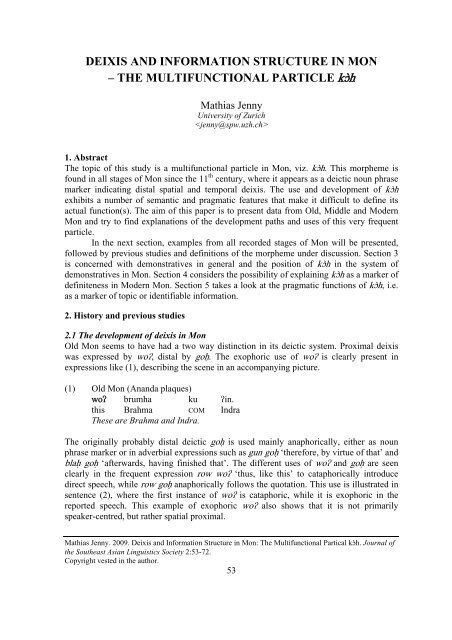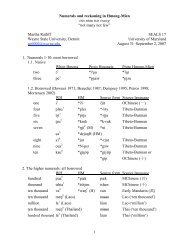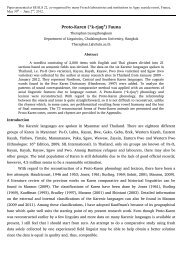proto-southwestern-tai revised: a new reconstruction - seals 22
proto-southwestern-tai revised: a new reconstruction - seals 22
proto-southwestern-tai revised: a new reconstruction - seals 22
You also want an ePaper? Increase the reach of your titles
YUMPU automatically turns print PDFs into web optimized ePapers that Google loves.
DEIXIS AND INFORMATION STRUCTURE IN MON<br />
– THE MULTIFUNCTIONAL PARTICLE kɔ̀h<br />
Mathias Jenny<br />
University of Zurich<br />
<br />
1. Abstract<br />
The topic of this study is a multifunctional particle in Mon, viz. kɔ̀h. This morpheme is<br />
found in all stages of Mon since the 11 th century, where it appears as a deictic noun phrase<br />
marker indicating distal spatial and temporal deixis. The use and development of kɔ̀h<br />
exhibits a number of semantic and pragmatic features that make it difficult to define its<br />
actual function(s). The aim of this paper is to present data from Old, Middle and Modern<br />
Mon and try to find explanations of the development paths and uses of this very frequent<br />
particle.<br />
In the next section, examples from all recorded stages of Mon will be presented,<br />
followed by previous studies and definitions of the morpheme under discussion. Section 3<br />
is concerned with demonstratives in general and the position of kɔ̀h in the system of<br />
demonstratives in Mon. Section 4 considers the possibility of explaining kɔ̀h as a marker of<br />
definiteness in Modern Mon. Section 5 takes a look at the pragmatic functions of kɔ̀h, i.e.<br />
as a marker of topic or identifiable information.<br />
2. History and previous studies<br />
2.1 The development of deixis in Mon<br />
Old Mon seems to have had a two way distinction in its deictic system. Proximal deixis<br />
was expressed by woʔ, distal by goḥ. The exophoric use of woʔ is clearly present in<br />
expressions like (1), describing the scene in an accompanying picture.<br />
(1) Old Mon (Ananda plaques)<br />
woʔ brumha ku ʔin.<br />
this Brahma COM Indra<br />
These are Brahma and Indra.<br />
The originally probably distal deictic goḥ is used mainly anaphorically, either as noun<br />
phrase marker or in adverbial expressions such as gun goḥ ‘therefore, by virtue of that’ and<br />
blaḥ goḥ ‘afterwards, having finished that’. The different uses of woʔ and goḥ are seen<br />
clearly in the frequent expression row woʔ ‘thus, like this’ to cataphorically introduce<br />
direct speech, while row goḥ anaphorically follows the quotation. This use is illustrated in<br />
sentence (2), where the first instance of woʔ is cataphoric, while it is exophoric in the<br />
reported speech. This example of exophoric woʔ also shows that it is not primarily<br />
speaker-centred, but rather spatial proximal.<br />
Mathias Jenny. 2009. Deixis and Information Structure in Mon: The Multifunctional Partical kɔ̀h. Journal of<br />
the Southeast Asian Linguistics Society 2:53-72.<br />
Copyright vested in the author.<br />
53





